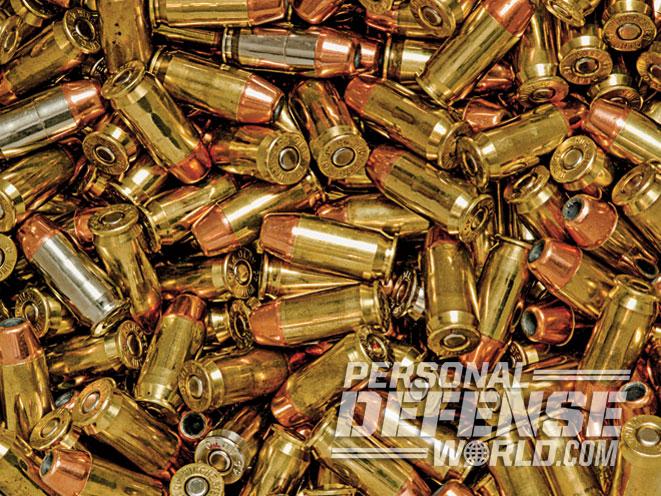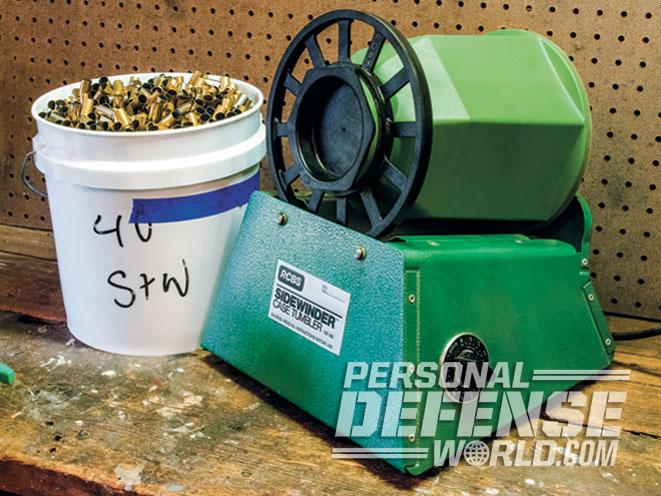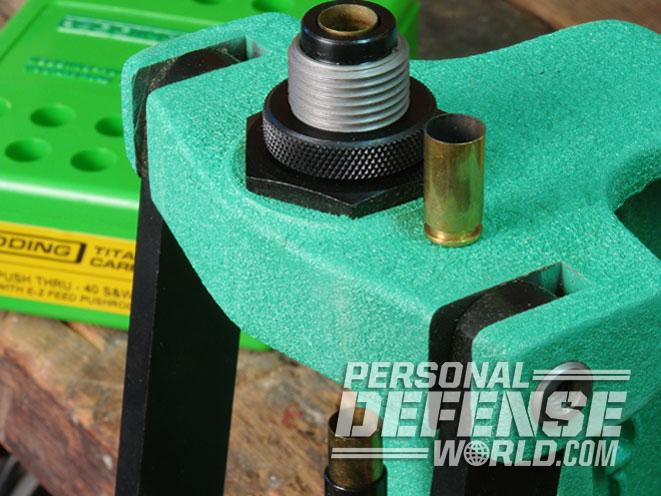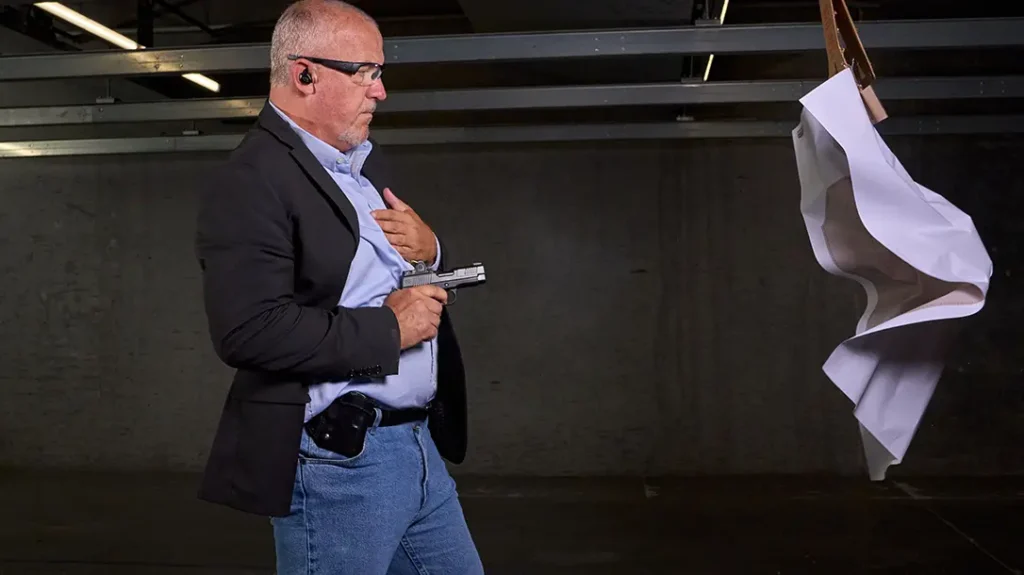It is amazing how many shooters have little concern for the environment. I am often shocked when they simply walk away after spending time on the range, leaving the litter of their pistol cases on the ground. I see it as my civic duty to clean up the area, or at least clean up those made for the calibers I reload. In the interest of “going green,” at least in a gun guy sort of way, I make sure to set a positive example for recycling brass shell casings.
I have been recycling brass shell casings for years—when the shooting is over and most everybody else is in the parking lot enjoying a cool drink, I am on my knees picking up brass. Because when it comes to brass shell casings, I believe a shooter can never have enough. Natural attrition constantly eats at the supply. The neck splits, or in some cases hide in the tall grass and can’t be found, so we sacrifice those to the “Range Gods” in return for good luck.
The point is, when it comes to handgun shooting, there can be a lot of ammo expended at the public range. And, a regular shooter needs to constantly be working on replenishing his or her brass supply. If I don’t have several thousand cases for each pistol cartridge on hand to load during the long, cold New England winters, I start to suffer withdrawal symptoms. So I defy my protesting knees and ignore my aching back and pick up all of the brass on the range that I can find.
Advertisement — Continue Reading Below
But before you can load your newfound treasure, you need to treat it right. If you simply pick up range brass and then dump it into the case feeder on your progressive loading press, you will get a very expensive and frustrating lesson on the cost of cutting corners. Recycling brass shell casings requires some patient nurturing.
Step 1: Remove Dirt and Debris from the Shell Casings
Range brass is usually full of sand and dirt. Often it’s been walked on and ground into the dirt. If it has been laying around through a rainstorm or two, the inside will often be filled with dirt or sand. The least little bit of sand can scratch an expensive sizing die, and it doesn’t take much more to jam up the loading machine. If the case has dirt packed inside and you load it, you may get a high-pressure surprise that can cause you to have a very bad day.
RELATED STORY: High-Volume Handloading – Time-Saving Tips For Using a Progressive Press
Advertisement — Continue Reading Below
The first step is to separate as much of the dirt and debris from the brass as you can. I like to put the brass in a mesh bag or, better yet, a plastic bucket with holes drilled in the bottom, and then shake the daylights out of it. Do it in small lots of about 100 cases at a time. This will help remove a lot of the loose dirt and sand in the casings.
Step 2: Wash the Brass
The next step is to wash the brass. I put mine in a case tumbler with some water and a small amount of low-foam detergent. Or, if the cases are very dirty, I use the RCBS liquid case cleaner. Then rinse the cases several times with clean water. If you don’t have a tumbler, put the cases in a bucket with a lid, add water and detergent and shake it. Let it soak for a few hours to loosen up the dirt inside the cases and shake some more. Then rinse and shake until you don’t see any more dirt in the water.
Advertisement — Continue Reading Below
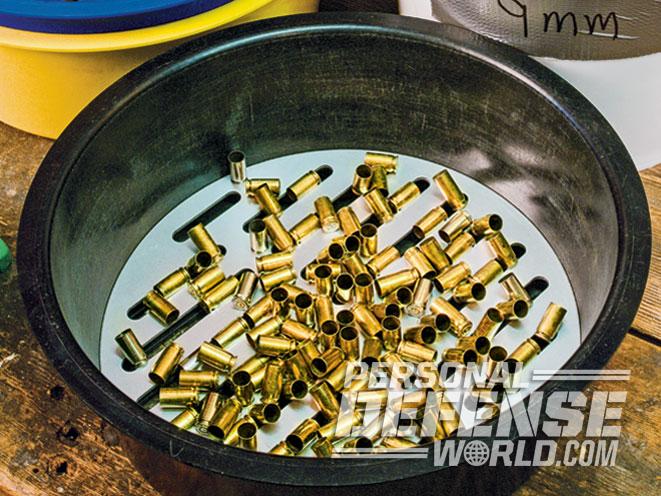
Step 3: Sort the Brass Casings
After washing, I sort the brass. The Shell Sorter (sold by Dillon and other reloading suppliers) has taken a lot of the tedium out of this chore. The Shell Sorter is three plastic pans with slots in the bottom that are sized to allow some cases to pass while holding the others. The first one will have .45 ACP and similar-sized cases left, the next .40 S&W size and the last 9mm and similar size cases. The trick is to not overload them, but do the brass in small lots. Of course, even then you will need to hand-sort at the end. For example, the .40 S&W tray will also have .357 SIG cases. The 9mm will have .38 Super and .380 ACP. The Shell Sorter has an optional .380 plate to allow easy passage of the .380 cases, and this sorts them from the 9mm. But you will still have .38 Super cases in with the 9mm that must be sorted by hand.
RELATED STORY: .45 ACP vs 9mm – 14 Experts Give Their Answers
You May Have to Sort Casings by Hand
Another problem is that cases will stick inside of each other. The .40 S&W cases will stick inside the .45 ACP and 9mm will stick in the .40 S&W. Sometimes you will find all three stacked up. You will need to pull them apart, not only to sort them but also because the water will not evaporate after washing if they are stuck together. Check to make sure there is not any dirt remaining inside the cases after they are separated.
Advertisement — Continue Reading Below
Not All Casings Can Be Reloaded
Throw out any aluminum or steel cases, as they cannot be reloaded. If a case is badly corroded, toss it. Simple dents and dings are fine, but any case that is crushed enough to have a kink should be tossed. After sorting, let them dry for several days. At least once a day mix them up and shake the buckets or boxes they are in to eliminate any water pooling in the cases.
Step 4: Place Casings in a Case Cleaner
Once they are dry, dump the cases in a vibrating case cleaner with ground corncob medium and run the machine for several hours, making sure it’s long enough to clean even the dirtiest cases. The best way to separate the cases from the medium after cleaning is to put them in a closed basket-style separator and rotate them until the medium stops falling out. I store the cases in 2-gallon paint buckets, each labeled for a specific cartridge.
Advertisement — Continue Reading Below
Step 5: Resize the Casings
The problem with recycling brass shell casings is you don’t know the casing’s history. So any .40 S&W brass should be run through a Redding GRx die. The new carbide version is the only way to go in my opinion, as you do not have to lubricate the cases first or clean off the lube after. This die eliminates the bulge that forms in the case from the unsupported section of the chamber in some .40 S&W pistols. This bulge can cause chambering problems with the loaded ammo and should be removed. Standard sizing dies cannot get all of it due to the relationship of the shell holder and die, which prevents the sizing die from going down on the case far enough. The GRx die forces the case all the way through the die so that it is completely resized.
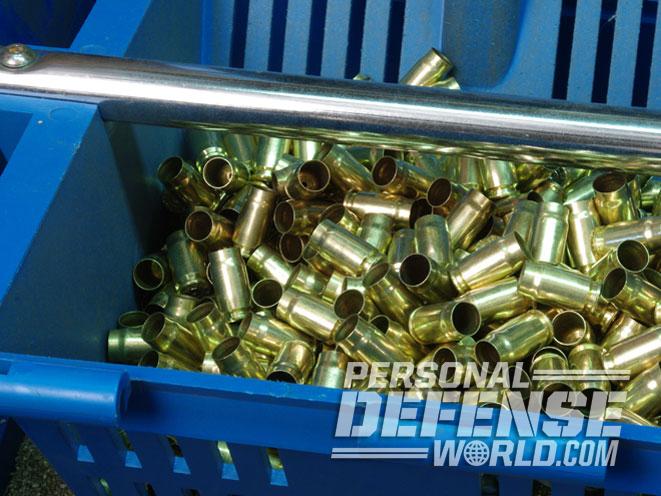
Step 6: Reload the Clean Brass Casings
What is in your buckets now are clean brass cases ready to load. But it’s a mixture of brands and headstamps. Sorting it all is too much work for me. So, I simply pick a mid-range load that will be safe in any case, something about halfway between the starting and full power load. This allows me to simply load the cases and shoot without worry. The accuracy is more than adequate, particularly for shooting at pistol ranges. If I need to load ammunition hot to make power factor or for hunting, I don’t use range brass. I save my range brass for light practice loads.
Advertisement — Continue Reading Below
All the loaded cartridges are checked with a case gauge before shooting. This checks to make sure the cartridge will chamber in the pistol. Oh, and one last tip—get knee pads. Greatest invention ever!
